-
“Chyrp is a blogging engine designed to be very lightweight while retaining functionality. It is driven by PHP and MySQL (with some AJAX thrown in), and has a pimpin’ theme and module engine, so you can personalize it however you want.”
Demonstrating Snap – the Syndicated Next Action pattern – at Web Directions North 2008
06 February 2008
I recently worked with Matt Webb on a proof-of-concept for a new interaction pattern for web applications, that we’ve nicknamed Snap. Matt demonstrated this pattern in his closing keynote at Web Directions North. Matt’s presentation, entitled “Movement”, is now online, as is a longer explanation of the Snap pattern at the Schulze & Webb blog.
Given Matt’s side of things is now online, it seemed only right that I share my side of the story.
We’re demonstrating a concept that’s previously been referred to as RSS-I – “RSS for Interaction“. This is an idea Matt mentioned in his ETech 2007 keynote, from Pixels to Plastic, and also in a presentation from Barcamp London in 2006. Here’s Cory Doctorow writing about the first mentions of the idea. Matt’s new name for this pattern is a bit catchier: Snap, which stands for “Syndicated Next Action Pattern”.
If you’ve read those links, it’ll describe a certain pattern for interaction. If you’re lazy, and haven’t read them, in a nutshell: what if RSS feeds could prompt you not only to updated and new content, but also actions that need to be performed?
This is the kind of thing best explained with a demonstration. And so Matt asked me to build a small application – a to-do list program – to demonstrate Snap at WDN. Our application isn’t anything fancy, and it won’t replace your GTD app of choice just yet, but it does demonstrate some of the interactions that Snap affords rather neatly.
You can watch a short screencast of the application here (The application is called “Dentrassi”. For more on that, see this footnote).
In the application, a user can add todo-list items to it, set a priority, and “tag” them as belonging to a project. There are several listing views of the data in the application. The inbox shows all items in progress that don’t belong to a project (ie: aren’t tagged). There are list views for each tag, and also for items that have been deferred to the future. So far, so good.
All of this data is also available as Atom feeds. The Atom feeds present the same information as the website, with one neat difference: at the bottom of every item, there’s a form embedded. And in that form, you can do everything you can do to the item on the site: defer it, tag it, complete it, or trash it.
So not only can you read all the data you’d normally see on the site, you can also interact with it, without leaving your feed reader. When you complete a successful interaction, a big tick appears.
The big tick was something we stubmled upon whilst we were making Dentrassi. If you’re on the web-app side of Dentrassi, and you mark an action completed, you get a typical Rails-style “flash message” letting you know what’s happened. This was also the case in the feed, to begin with – you’d post the form, and then the web page would render inside the feedreader’s viewport. Which is OK, but not great. Then we hit upon the idea of treating requests from feedreaders and browsers differently. There’s no magic user-agent-sniffing – the RSS feeds have an extra hidden field, that’s all. When that field is set, you get a big tick (or a big cross, if you try to work on stale data). You can see in the video that Matt’s added a really simple “add another task link” to the “big tick” page in certain states, to speed up task entry. Once the big tick was in place, it started to feel like I was actually making a thing, rather than a hack.
There’s also an extra feed, which we’ve called the admin feed. This only ever has two items: a generic message telling you the state of the system – how many things are in it, how many are completed – and a form that lets you create a brand-new todo. From your RSS reader.
That’s it. It’s not very sophisticated, but it demonstrates the interaction Matt’s described pretty well: the syndication of interaction, rather than content.
What’s the future for this kind of thing? I don’t know. “Enclosures for interactions” was the best way I could describe one future I’d like for it: the idea that endpoints for interactions could be specified just as we currently specify things like referenced media files; then the user interface for Snap is down to the tool, rather than the feed itself. That’s easily the most exciting future, but it requires standards, and toolmaker support, and people like Tim or Sam to be onboard (or whoever the Tim and Sam of Snap might be), and all that takes time.
(And: when you can let the agent define the interface, what interfaces you could build! I suggested pedals – I can have my yes/no tasks up in a window and rattle through them with my feet whilst I’m reading, or writing email, or whatever, just like foot-controlled dictation machines. Because Snap emphasises, rather than obscures, the natural flow state we get into when we’re working our way down a list, it generates a sense of immediacy around the simple action of “doing tasks”. The forms can be contextual to the actions in question – complete/wontfix, yes/no, attend/watch – whilst the actual interaction the user performs remains the same.)
Snap also demands different kinds of RSS readers. Traditionally, readers cache all information, meaning as items “fall out” of the feed they remain within your feed reader. But we don’t want that; we’d like items that fall out to disappear. A Snap feedreader should be an exact mirror of all the atom feeds available to it, not a partial mirror.
That’s precisely the opposite behaviour of existing, content-oriented feedreaders. Right now, most of what we’ve shown is a little bit of a hack: we’re relying on the fact that, for whatever reason, you can use <form> elements in an Atom feed, we’re relying on this being a local application, for a single user, and we’re relying on it working on a very limited number of user agents (I’ve only tested NetNewsWire and Vienna so far). There’s a way to go before full-scale RSS-I is possible – but there’s nothing to stop people taking a simple, hacky approach right now.
And so that’s what we did. Because a simple, hacky approach that exists beats any amount of RFC-drafting and hypothesising. The most valuable thing we have to show for this so far is that it works.
How it works doesn’t really matter. As such, you’re almost certainly never going to be able to download the source code for this application. The code really isn’t important; it’s not bad at all, but to distribute it would be to miss the point. What we’re trying to demonstrate with this is a particular interaction, and that can be demonstrated through narratives, screengrabs, and screencasts.
That’s all there is to say; Matt’s longer post on his company blog encompasses everything I’ve not mentioned here (and a few things I have), and as such, should be viewed as a companion piece. It’ll be interesting to see what happens from here – how, as things like Action Streams take hold, patterns like Snap have a growing place in the web ecology. It’ll also be interesting to see what happens with, say, standards for these kinds of things – enclosures and the like – and how the tool manufacturers react. All in all, it was a fun project to work on, and I hope other people find the interaction as exciting as Matt and I do.
(Matt mentions that I nicknamed that application “Dentrassi”. I find it useful to have names for things; when I’m sitting at ~/Sites/ and am about to type rails foo to kick off a new project, it’s nice to have something – anything – to call the application. I thought about DEmonstrating RSSI, and the only word in my head that had things in the right order was DEntRaSSI. The Dentrassi, for reference, are an alien race from the Hitch-Hiker’s Guide to the Galaxy. I’m not a Douglas Adams nut, or anything – it was just the only word in my head at the time. So rails dentrassi it was, and off we went.)
-
“The book addresses our philosophy in creating products and services, the importance of the right kinds of research, of making design an organizational competency, [and] of thinking of your offerings as part of a larger system…” Looks good!
-
SixApart’s MySQL DBA shares some thoughts on running tight ops ships. Lots of good wisdom in here.
-
Dan Saffer’s talk from Institute of Design’s 2007 Design Research conference is now available online. Entitled “How To Lie With Design Research”, it’s an entertaining look at the many ways you can do evil things with research. Made me chuckle quite a lo
-
“While this implementation of the API was based on publicly discoverable information (like Google’s), we simply didn’t feel comfortable shipping that project based on current implementations.” Interesting corollary to the Social Graph API.
-
“Developing a compelling presentations involves a series of decisions and exercises to align your head with the fact that you’re delivering your content directly to people. No internet. No weblog. Just you.” Rands on presentations and speeches.
-
“Manage your conference notes and share them with other delegates, even with unreliable conference wi-fi!” Based on Tiddlywiki – an early piece of output from BT’s Open Source division (and Osmosoft). Congrats to Jeremy!
-
Lovely; as leonardr says, a “2D Super Mario Galaxy”. Hop around planetoids rescuing kittens. Ace!
-
“SwitchPipe is a proof of concept “Web application server” or, more accurately, a Web application process manager and request proxy.” Wow. Peter Cooper comes good on his “RBoss” concept. Could be interesting to see if there’s mileage in this.
-
“The idea is something I’m calling web hooks…simple server-side mechanisms for web applications that allow users to do what they want with their data. You just let them specify URLs for various events…to pass data or notifications to in real-time.”
-
“why on earth do we believe that just because technology can expose people means that it should?” danah, as ever, very insightful, on the problems of exposing user data, regardless of whether it is already “public” or not.
-
“We believe that the interests of Internet users come first — and should come first — as the merits of this proposed acquisition are examined and alternatives explored.”
-
“Yesterday, I discovered that The Times (UK), a well-respected newspaper owned by News Corp., is involved in an extensive campaign to spam social media websites with links to Timesonline.co.uk articles.” Andy Baio on the Times’ involvement with SEO.
-
“Mixed media artist Mark Khaisman layers several pieces of [parcel] tape on Plexiglas panels to create these memorizing rustic illuminations with textures much like a knife painting with broad wide strokes.”
-
“I don’t think I’ve read an article in the last year that speaks about email as much other than an irritant.” This one, however, makes some very interesting claims.
-
Hosted subversion and continuous integration specifically for Rails development. Looks interesting; reasonably competitive pricing.
Caxton in Hi-Def
30 January 2008
Spotted in Eurogamer’s review of Rez HD:
Back in the day we said of the original: ‘When Rez eventually turns up cheaply it will become indispensable, but until then it’s a luxury.’ Xbox Live Arcade is, then, our modern printing press: digital distribution transforming the expensive and exclusive into the affordable and inclusive.
Emphasis mine. I liked that quite a lot.
-
“…it became painfully clear that most business people are unaware of their role in the system… What I found was that many powerful people desperately want to help solve these problems but they seem unaware of their role in perpetuating some of the ill
-
“This little hack adds find-as-you-type to Safari, Apple’s OS X web browser”
-
“researchers found that information workers whose strong e-mail networks allow them to receive new information sooner than their peers…are likely to be more productive than their less well-connected counterparts”
-
Notes from a talk by Will Wright in 1996. So much good stuff in here; it’s almost certainly going to get a dedicated blogpost soon.
-
There are no software applications in the traditional sense… The laptop focuses children around “activities.” This is more than a new naming convention; it represents an intrinsic quality of the learning experience we hope the children will have”
Blog all well-worn products: Logitech VX Nano
23 January 2008
I bought a new mouse recently, and was very impressed with it as a piece of product design – so much so that, much like Jack and his Bang and Olufsen radio, I felt it was worth writing about a bit. (Apologies to Mike Migurski for paraphrasing his “blog all dog-eared pages” concept)
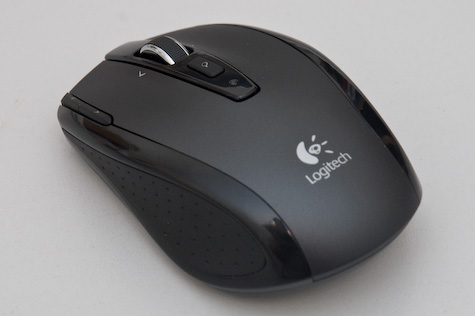
This is the Logitech VX Nano. It’s a wireless laptop mouse, so it’s quite small. It’s not bluetooth; it has a wireless receiver.
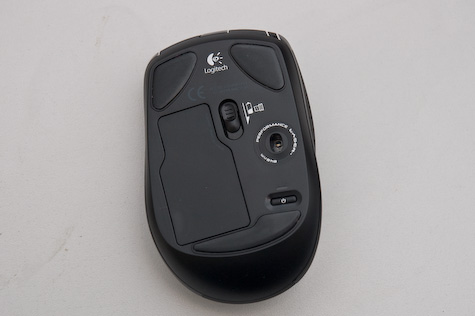
The wireless receiver is stored inside the battery compartment, on the underside.
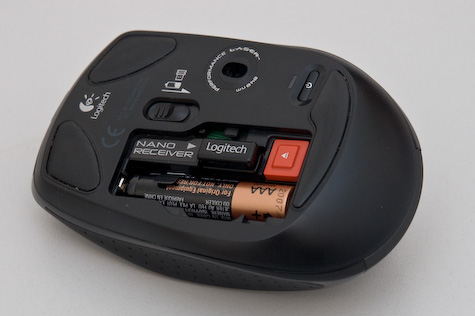
Here’s the view inside the battery compartment: two AAA batteries stacked, and the receiver just above it. You push the eject button to pop the receiver out. When you pop it out, the mouse turns on; when you click it in, it turns off. You can also turn the mouse off with the power button you can see – eg, when you’re putting your laptop to sleep.
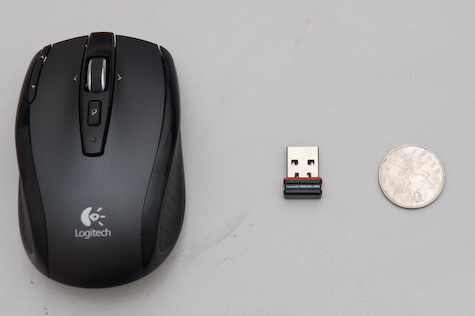
And here’s the receiver. That’s why they call it Nano. Impressive, eh? The reason the receiver’s inside the battery compartment is that they don’t expect you to unplug it from your laptop much – it’s small enough to leave in all the time. Like so:

It’s so small it doesn’t even stick out the side of the new Apple keyboards.
So the receiver’s a marvellous feat of engineering. But it doesn’t stop there; it’s also a lovely mouse to use.
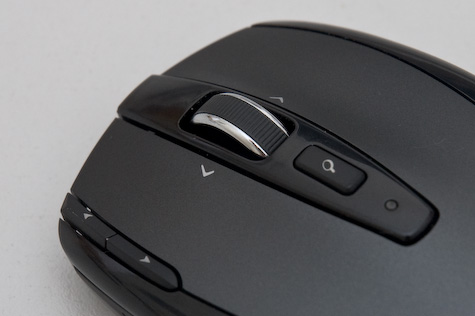
There are five buttons: left and right, obviously; button 3 is the small “search” button; buttons 4 and 5 – nominally back and forward – can be seen top left.
What’s really exciting is the mousewheel.

The wheel is weighty, metal, and has a rubberized grip. It’s 2D – you can nudge it left and right. That’s not the cool bit, though.
When you move the scrollwheel, to begin with, it subtly clicks as it passes each detent. So far, so scroll wheel. However, when you push it down, it clicks very loudly, and with a great mechanical feeling. And then, when you spin it… there’s no resistance. It spins entirely freely; the ratchet disengages. And all of a sudden, you understand why it’s a weighty bit of metal – it acts as a flywheel, and spins very freely. You can gently roll it, flick it, and stop it immediately with a light touch. And then a single click puts it back to detented mode.
It’s a wonderful device; a really nice mouse, with lots of lovely design features that manage to be stylish, technically brilliant, and genuinely useful; I’m enjoying it more than my previous Microsoft laptop mouse (which was great, despite its somewhat oversized receiver).
One last touch I really liked. This:
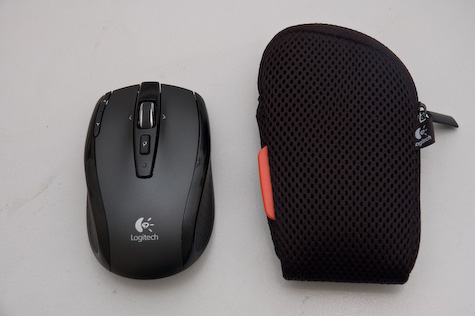
It even comes with a small mesh bag for you to put it in. Why do I like that? Well, it shows that Logitech know that a) you’re going to transport the mouse around a lot and b) that they want you to treat it as a premium product. If you throw it into your bag, it’s going to get all dinged up and scuffed in no time. So you also get a nice, fairly anonymous, perfectly-sized neoprene/mesh bag.
It’s the little touches that make a lot of the difference. A thoroughly recommended product – and it still makes me grin every time I eject that receiver.